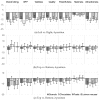"Seeing What's Left": The Effect of Position of Transparent Windows on Product Evaluation
- PMID: 30217090
- PMCID: PMC6164523
- DOI: 10.3390/foods7090151
"Seeing What's Left": The Effect of Position of Transparent Windows on Product Evaluation
Abstract
The position of design elements on product packaging has been shown to exert a measurable impact on consumer perception across a number of different studies and product categories. Design elements previously found to influence the consumer through their positioning on the front of pack include product imagery, brand logos, text-based claims, and basic shapes. However, as yet, no empirical research has focused specifically on the relative position of transparent windows; despite the latter being an increasingly prevalent element of many modern packaging designs. This exploratory online study details an experimental investigation of how manipulating the position of a transparent window on a range of visually-presented, novel packaging designs influences consumer evaluations and judgements of the product seen within. Specifically, 110 participants rated 24 different packaging designs (across four product categories: granola, boxed chocolates, pasta, and lemon mousse; each with six window positions: in one of the four quadrants, the top half, or the bottom half) in a within-participants experimental design. Analyses were conducted using Friedman's tests and Hochberg procedure-adjusted Wilcoxon Signed-Rank Tests. Window position was found to be a non-trivial element of design, with a general preference for windows on the right-hand side being evidenced. Significantly higher scores for expected product tastiness and design attractiveness were consistently identified across all product categories when windows were positioned on the right- vs. left-hand side of the packaging. Effects on the perception of powerfulness, overall liking, quality, and willingness to purchase were identified, but were inconsistent across the different product categories. Very few effects of window verticality were identified, with expected weight of the product not being significantly influenced by window position. The implications of these findings for academics, designers, and brand managers are discussed, with future research directions highlighted.
Keywords: expected taste; food judgements; packaging; packaging design; position; transparent packaging.
Conflict of interest statement
The authors declare no conflict of interest.
Figures


References
-
- Food Marketing Institute Supermarket Facts. [(accessed on 16 July 2018)]; Available online: https://www.fmi.org/our-research/supermarket-facts.
-
- Spence C. Integrating the Packaging and Product Experience in Food and Beverages. Elsevier; Oxford, UK: 2016. Multisensory packaging design: Colour, shape, texture, sound, and smell; pp. 1–22.
-
- Stoll M., Baecke S., Kenning P. What they see is what they get? An fMRI-study on neural correlates of attractive packaging. J. Consum. Behav. 2008;7:342–359. doi: 10.1002/cb.256. - DOI
-
- Velasco C., Salgado-Montejo A., Marmolejo-Ramos F., Spence C. Predictive packaging design: Tasting shapes, typefaces, names, and sounds. Food Qual. Prefer. 2014;34:88–95. doi: 10.1016/j.foodqual.2013.12.005. - DOI
-
- Vilnai-Yavetz I., Koren R. Cutting through the clutter: Purchase intentions as a function of packaging instrumentality, aesthetics, and symbolism. Int. Rev. Retail Distrib. Consum. Res. 2013;23:394–417. doi: 10.1080/09593969.2013.792743. - DOI
LinkOut - more resources
Full Text Sources
Other Literature Sources
Molecular Biology Databases

